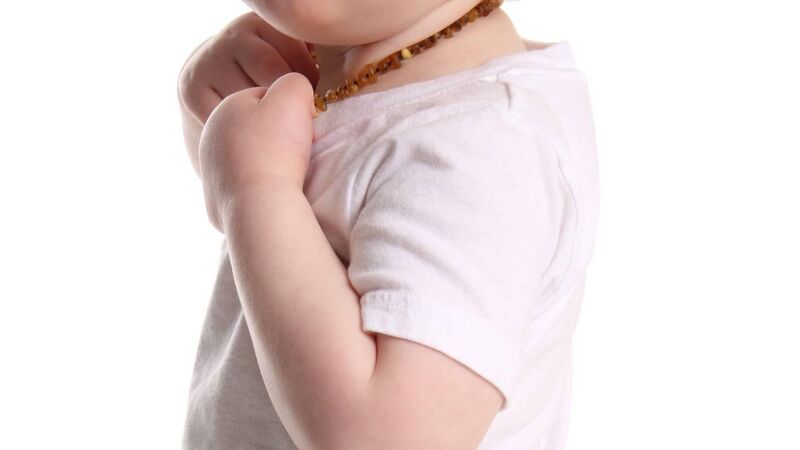Teething jewellery joins watchdog ban list

Amber teething jewellery can come apart in a baby’s mouth, causing the baby to choke or to swallow the beads. Picture: iStock
The Competition and Consumer Protection Commission (CCPC) has stopped the sale of dangerous amber teething jewellery by a number of Irish retailers.
Amber bead products are increasingly advertised and sold in Ireland and across Europe as teething aids in the form of necklaces, bracelets and anklets. However, these products pose serious risks to babies and small children, including risks of strangulation and choking.
This week is Child Safety Week, and the CCPC is calling on all businesses to stop selling or marketing these products as teething aids.
Acting on consumer reports, CCPC product safety experts approached multiple distributors across Ireland, requiring them to remove all amber teething jewellery from sale, both instore and online.
As part of the investigation, the CCPC also worked closely with the HSE to provide up-to-date information on amber teething jewellery to businesses. The CCPC is also working with other European product safety authorities to track down companies supplying these products to Ireland.
Grainne Griffin is director of communications at the CCPC. She said while teething can be a distressing and often exhausting time for parents and children alike, this dangerous jewellery is not a remedy, it’s a risk.

“Amber teething jewellery can come apart in a baby’s mouth, causing the baby to choke or to swallow the beads. Also, as with any cords around a baby or child’s neck, there is a risk of strangulation.
"Thanks to the callers who reported these products to our helpline, we were able to step in and get those businesses to stop selling amber beads as teething aids for babies.”
Dr Abigail Collins is HSE national clinical lead, Child Health Public Health. She said not only was there a strangulation and choking risk, there is no convincing evidence to support claims amber teething jewellery provides pain relief.
“It can be upsetting for parents to see babies and young children in discomfort from teething. Depending on their age and stage, you can use teething rings, sugar-free teething gel or cold water and healthy foods to chew on.”
"It’s vital to never put any kind of cord, string or chain around a baby’s neck, and to keep small objects like beads away from babies and small children.
The CCPC says it will take appropriate action against suppliers and retailers who sell or advertise these products as teething aids.
While this product alert ranks among the more serious of those issued by consumer authorities, product recalls and alerts happen all the time.
‘Safety Gate’ is an EU-wide system that allows consumer authorities across the union to share information about dodgy non-food items. Each alert contains information on the kind of product detected as dangerous, a description of the risk and the measures taken to deal with it. Every alert is followed up by the other authorities, which take their own measures if they find the same product in their markets.
In 2023, authorities from the 30 participating countries of the Safety Gate network (EU member states plus Norway, Iceland and Liechtenstein) validated no fewer than 3,412 safety alerts on Safety Gate — a 37% increase on 2022.
According to Safety Gate’s annual report, that increase does not mean there are more dangerous products on the market. Rather, "it reflects a stronger commitment to market surveillance on the part of national authorities".
Apart from the higher number of alerts in 2023, the breakdown by product category was also quite different from the pattern observed in previous years. Market surveillance enforcement authorities increased their monitoring of cosmetics to check for the presence of banned dangerous chemical ingredients. As a result, ‘Cosmetics’ was the product category with most alerts in Safety Gate. ‘Toys’ and ‘Motor vehicles’, which in previous years had the largest share of alerts, were moved to second and third places.
The CCPC continues to highlight the risks posed to consumers by poor quality, unsafe or non-compliant products, and toys in particular. It has created a checklist of what to look out for to make sure consumers are safety aware.
First of all, check for the CE mark on children’s toys before you buy them. The CE mark is a manufacturer’s declaration the product complies with EU safety regulations and standards.
The mark should be easy to see, either on the product, in the instruction manual or on the packaging. When buying toys online, check for the CE mark as soon as the package arrives. If there is no visible CE mark, send it back. Under consumer protection law, you have 14 days from when the goods arrive to notify the business you wish to cancel your order, and a further 14 days to return the goods.
Secondly, always buy from a reputable dealer. This will help you to avoid unsafe, non-compliant toys, or indeed toys with a fake CE mark.

One of the biggest dangers for children is small or detachable parts of toys, because these can lodge in little ears, noses and throats. A €2 coin is good reference point. Anything smaller is a potential choking hazard for children aged up to three years.
Check age guidance instructions on all children’s toys, in particular those designed for children under three. Age labelling is the manufacturer's way of telling you whether the toys are safe for a child of a particular age. It is also important to consider any younger children who may be in the same house as the intended recipient.
Finally, check for sharp edges, long cords or cables. Be sure to avoid dangerous or fold-away parts, or small holes that could trap children’s fingers.
So what do you do if you have bought a product that has been recalled? First off, let the retailer know. It may turn out to be a once-off fault, in which case you are entitled to a repair, a replacement, a reduction in the price or a refund. You will need proof of purchase such as a receipt or bank or credit card statement. If you are still not satisfied, get in touch with the CCPC.
If you hear about a product recall and think you are affected, check the product recall details on the CCPC site. It may only be a specific batch being recalled, or it might just affect certain countries.
And if you are have found an unsafe product, contact the CCPC helpline on 01 402 5555 or contact the commission through the website, ccpc.ie.
Read More










